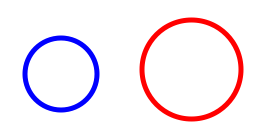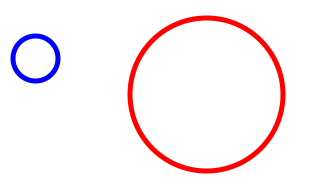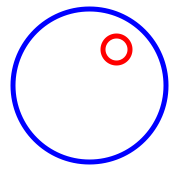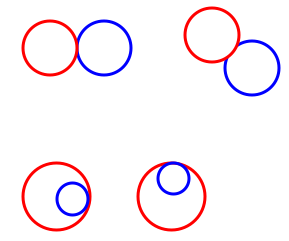Skip over navigation
Two very special circles are on the floor:

Very special because they can get bigger or smaller - as you like.
So you might like them to be like this:

Maybe you like things small - so you would have:

I'd like the blue one to grow:

Whoa! That looks different.
The Red is inside the Blue.
So the Red and the Blue can grow - just as you like.
We've seen the Red INSIDE the Blue.
Can we change things so that we might use other words like:
Have a go. Send us some pictures of what you do - we'd love to see them.
If you enjoyed this problem, you might like to try 3 Rings .


Or search by topic
Number and algebra
Geometry and measure
Probability and statistics
Working mathematically
Advanced mathematics
For younger learners
2 Rings
Age 5 to 7
Challenge Level 





- Problem
- Getting Started
- Student Solutions
- Teachers' Resources
2 Rings
Two very special circles are on the floor:

Very special because they can get bigger or smaller - as you like.
So you might like them to be like this:

Maybe you like things small - so you would have:

I'd like the blue one to grow:

Whoa! That looks different.
The Red is inside the Blue.
So the Red and the Blue can grow - just as you like.
We've seen the Red INSIDE the Blue.
Can we change things so that we might use other words like:
TOUCHING?
OVERLAPPING?
OUTSIDE?
Have a go. Send us some pictures of what you do - we'd love to see them.
If you enjoyed this problem, you might like to try 3 Rings .
Why do this problem?
This problem provides a great environment in which to discuss the meaning of words related to position, for example touching, overlapping (some children have added "underlapping"), inside and outside.
Possible approach
You may decide to use real rings (perhaps wooden or plastic), or you could ask children to make some rings as part of the task, maybe out of pipe cleaners.
You could introduce the task in a large space outside, or in the school hall, using P.E. hoops, for example. You could lay out two hoops and ask the children to describe what they see. By asking a child to place two hoops in a different way, and talking about this as well, you will begin to build up useful vocabulary. You can then set children off on investigating other ways. You may need to
address how they are keeping track of the different combinations - perhaps they could draw each, or there may be enough equipment to keep each one once it is made.
As a plenary, you could invite a pair of children to describe an arrangement and encourage everyone else to try to draw or make it.
Key questions
What could you do if one of your rings was bigger/smaller?
How would you describe the two rings?
Questions could well arise in a discussion about these sets of two pairs, for example, and whether any are the same or different, and why.

Possible extension
Take the pupils onto the activity 3 Rings.
You may also like
Biscuit Decorations
Andrew decorated 20 biscuits to take to a party. He lined them up and put icing on every second biscuit and different decorations on other biscuits. How many biscuits weren't decorated?

